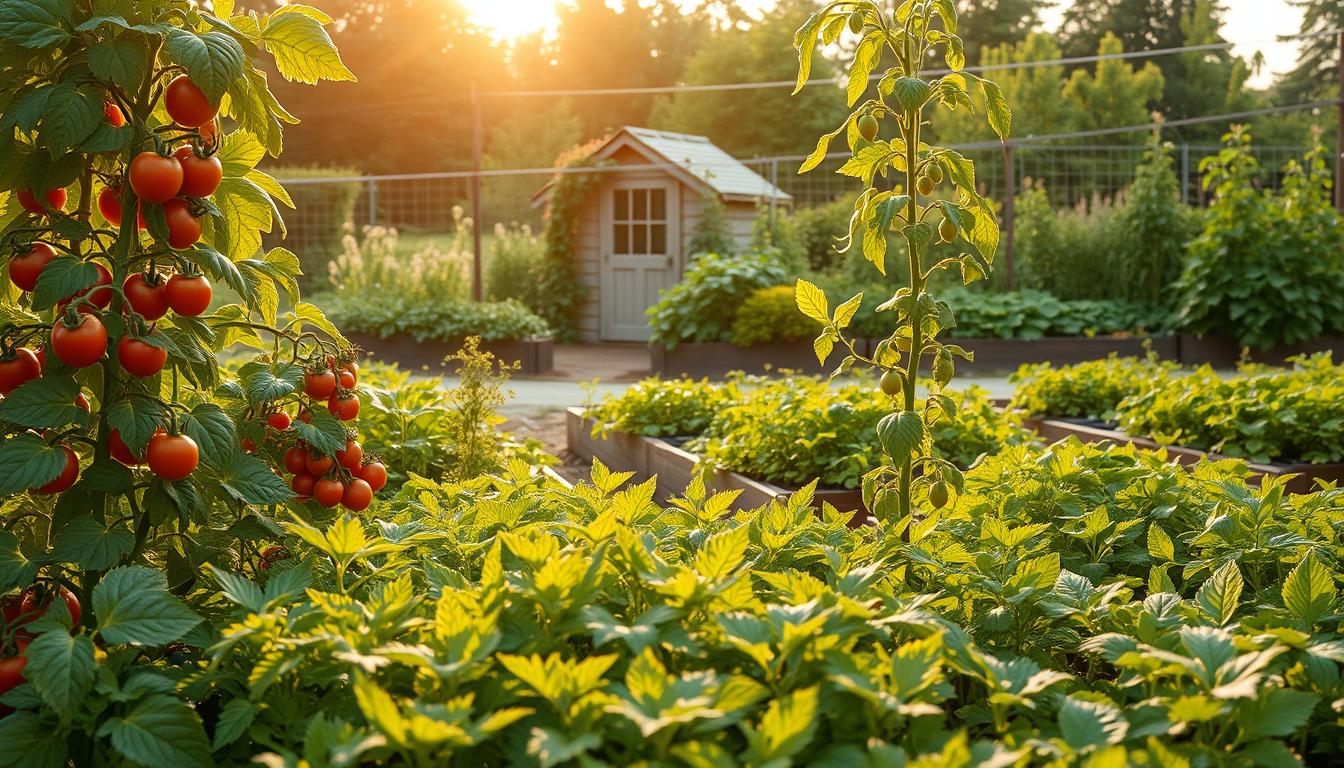Ever looked at your small backyard and wished it could produce more food? A garden revolution is underway. It might be your answer. Smart gardeners are growing twice as much in half the space with clever techniques.
These methods let you fit more plants in every square foot without harming them. By using space wisely, even small plots can become food powerhouses.
Urban folks with balconies or patios love high-density planting. It makes growing your own food possible, even with little space. You’ll also spend less time on weeding and watering.
These strategies work like natural ecosystems. Plants grow together, helping each other. They’re great for both new and experienced gardeners, offering a way to grow more with less effort.
The Revolution in Garden Productivity
A quiet revolution is changing how we garden, making it possible to grow more food than ever before. Today, gardeners are finding that they don’t need more land to grow a lot of food. Instead, they use the space they have more wisely.
This new way of gardening has brought a renaissance to growing food at home. Even those with small plots can now grow a lot of food.
Traditional Gardening vs. Modern Approaches
Old-school gardening often means long rows of one crop with lots of empty space in between. This method can leave up to 50% of the garden unused, open to weeds and erosion.
Modern intensive gardening, on the other hand, uses every inch of space. This method has roots in places like France and China, where land was scarce. The French intensive method, from the 1800s, showed that by planting densely in raised beds, you can grow much more food.
Today, we combine these old methods with new research on how to plant and which plants to pair together. This results in gardens that can grow 4-10 times more food per square foot than traditional gardens.
The Growing Need for Space-Efficient Solutions
As cities grow and suburban lots get smaller, gardening in small spaces is becoming more important. The U.S. Census Bureau says the average lot size for new homes has dropped by nearly 18% since 1992. At the same time, more people want to grow their own food.
This mix of smaller spaces and a growing interest in gardening has made high-density planting very appealing. Gardeners today are looking for ways to grow more in less space.
The magic of intensive gardening isn’t just about packing more plants into a small area. It’s about creating a system where plants help each other grow. Whether you have a big yard or a small balcony, these methods can turn your space into a food-producing paradise.
Intensive Planting Methods: Core Principles and Benefits
Intensive planting methods change how gardeners grow food in small spaces. Unlike old ways that waste space, these new methods use every inch. They’re not just about packing more plants in tight spots. They’re a smart way to work with nature and grow more food.
Fundamental Concepts and Philosophy
Intensive planting is all about making gardens like natural ecosystems. It starts with healthy soil, which is key for plants to grow well together. This way, plants can be closer than we thought possible.
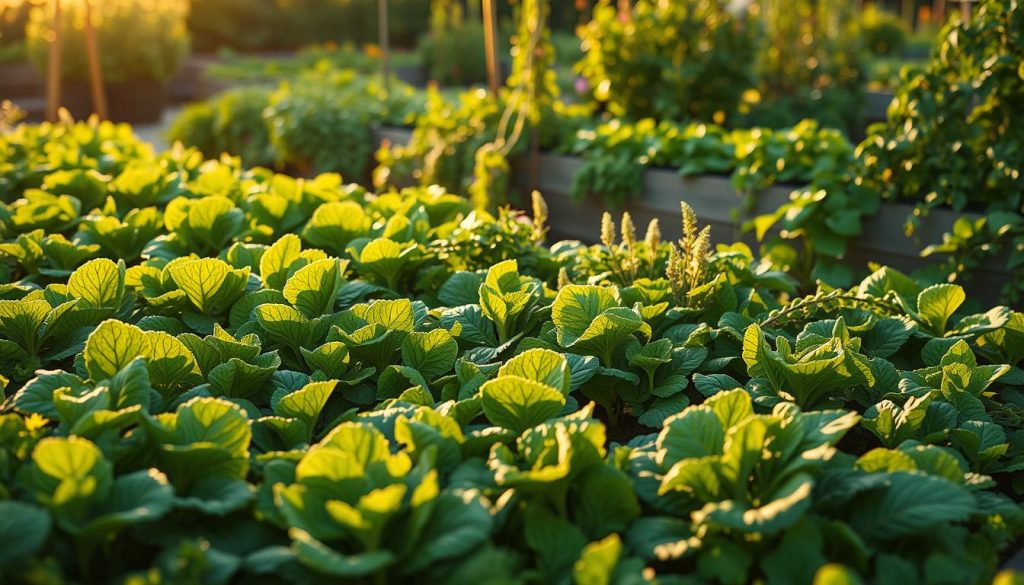
Four main ideas make up intensive planting. Plants are stacked vertically to use space better. Plants are paired to help each other grow. There’s a plan to keep plants coming in a row. And, gaps between plants are filled with fast-growing ones.
This approach respects nature more. It doesn’t try to control everything like old farming methods. Instead, it works with nature to grow more food in a sustainable way.
The Science Behind Higher Yields
High-density planting is backed by science. It can grow 4-6 times more food in the same space as old ways. This is because it uses less water and resources.
Plant spacing is key. Plants are arranged to catch all sunlight. This means less light is wasted on bare soil. Plants are placed so their leaves just touch at full growth.
How roots grow is also important. Plants with different roots use soil better together. This means less competition for water and nutrients.
| Factor | Traditional Gardening | Intensive Methods | Improvement |
|---|---|---|---|
| Space Utilization | 20-40% planted area | 80-100% planted area | 2-5x improvement |
| Water Efficiency | High evaporation loss | Minimal exposed soil | 30-50% less water |
| Weed Pressure | Significant open soil | Limited light reaches soil | 70-90% fewer weeds |
| Yield per Square Foot | Low to moderate | Very high | 4-6x higher yields |
Close planting creates good microclimates. The leaves catch less water, keep temperatures steady, and make the air more humid. This makes pests less common and helps good bugs thrive. The garden becomes more balanced and needs less help.
Square Foot Gardening: Maximum Yields in Minimum Space
The square foot gardening method is simple yet very productive. It was created in the 1980s by Mel Bartholomew, a retired engineer. This method divides garden space into 1’×1′ squares. It makes gardening easier and more productive for everyone.
This method is better than old ways of gardening. It uses space more efficiently and can grow up to four times more than before. It’s great for city gardeners and beginners with little space.
Implementing the Grid System
The key part of square foot gardening is its grid system. It turns raised beds into squares. You can make this grid with wood, cord, or twine.
The grid helps with spacing and planning. It’s easy for beginners to use. Each square is like a mini-garden with its own plants.
Optimal Soil Composition for Success
Good soil is key for square foot gardening. Mel’s Mix is a special blend of compost, vermiculite, and peat moss. It gives plants the nutrients they need.
Coconut coir is a good substitute for peat moss. It’s eco-friendly and works well. The soil should be light and full of nutrients for the plants.
Strategic Plant Selection and Spacing
Choosing the right plants and spacing them right is important. Use compact plants and vertical growers. Space them based on how big they’ll get.
| Plant Type | Plants Per Square | Spacing Pattern | Examples |
|---|---|---|---|
| Extra-Large | 1 per square | Center of square | Broccoli, Cabbage, Tomatoes |
| Large | 4 per square | 2×2 grid | Lettuce, Swiss Chard, Basil |
| Medium | 9 per square | 3×3 grid | Spinach, Beets, Bush Beans |
| Small | 16 per square | 4×4 grid | Carrots, Radishes, Onions |
This way of spacing helps plants grow well without taking up too much space. It’s easy for beginners to get great results. Square foot gardening is a great way to garden intensively.
Biointensive Agriculture for Home Gardeners
John Jeavons developed biointensive agriculture in the 1970s. It helps home gardeners grow more food in less space. This method creates a closed-loop system that sustains itself with minimal outside inputs.
It’s not just about packing more plants into a small space. It’s about creating a thriving ecosystem. This ecosystem produces abundant harvests while improving the soil year after year.
Biointensive gardening focuses on sustainability. It uses specific techniques for soil preparation, planting, and maintenance. Home gardeners can produce up to four times more food per square foot than traditional methods.
The initial investment of time and energy pays off. It leads to increased productivity and reduced work over time.
Deep Soil Preparation Techniques
The foundation of biointensive agriculture is in well-prepared soil. Unlike conventional gardening, biointensive methods create friable, aerated soil to depths of 24 inches or more. This deeper soil profile allows plant roots to access more nutrients and water.
Deep soil preparation creates a living sponge. It holds moisture longer during dry periods and drains better during wet seasons. Plants grown in deeply prepared soil develop stronger root systems.
These strong roots can mine nutrients from a larger soil volume. This reduces the need for fertilizers. It allows for the signature close spacing of biointensive gardens.
Double-Digging Method
The cornerstone technique of biointensive soil preparation is double-digging. This process begins by removing the top 12 inches of soil from a bed and setting it aside. Next, you loosen the lower 12 inches of soil with a fork without removing it.
Then, return the topsoil, creating a bed with 24 inches of loose, aerated soil. This encourages deep root growth.
Beyond physical soil structure, biointensive methods emphasize biological soil health. Adding mature compost introduces beneficial microorganisms and organic matter. These microbes form partnerships with plant roots, improving nutrient uptake and disease resistance.
Biointensive gardeners avoid tilling after the initial bed preparation. Instead, they use gentle surface cultivation to preserve soil structure and biology. This minimal disturbance approach protects the complex web of fungi, bacteria, and other soil life that supports plant health.
Companion Planting Strategies
Biointensive agriculture elevates companion planting from a casual practice to a science. Plants are carefully combined to create mutually beneficial relationships. These relationships maximize space while improving growth and reducing pest problems.
For example, the classic “Three Sisters” planting combines corn, beans, and squash. The corn provides a trellis for beans, beans fix nitrogen that feeds corn and squash, and squash leaves shade the soil and suppress weeds. Other effective combinations include carrots with onions to deter pests, or lettuce grown in the shade of taller plants like tomatoes.
| Plant | Good Companions | Benefits | Poor Companions |
|---|---|---|---|
| Tomatoes | Basil, Marigolds, Carrots | Pest repellent, flavor enhancement | Potatoes, Fennel |
| Beans | Corn, Sunflowers, Carrots | Nitrogen fixing, structural support | Onions, Garlic |
| Lettuce | Tall plants, Radishes, Carrots | Shade utilization, space efficiency | None significant |
| Carrots | Onions, Tomatoes, Sage | Pest confusion, space maximization | Dill, Parsnips |
Carbon and Calorie Farming
Biointensive agriculture has a unique approach to garden planning. It divides the garden into three functional areas. 60% is dedicated to carbon crops, 30% to calorie crops, and 10% to vitamin-rich vegetables.
Carbon crops like corn, wheat, and sunflowers produce large amounts of biomass. This biomass becomes compost material to feed the soil. Calorie crops such as potatoes, sweet potatoes, and grains provide the bulk of dietary energy needs.
The remaining space grows nutrient-dense vegetables. These vegetables supply vitamins and minerals or can generate income. This 60-30-10 formula creates a sustainable system where the garden generates enough organic matter to maintain soil fertility.
For home gardeners, this might mean growing more grains and root crops. A smaller portion is dedicated to typical garden vegetables.
Vertical Farming: Growing Up Instead of Out
Vertical farming changes how we grow food by using space up instead of out. When we don’t have much room, growing up can help us get more food. We can turn walls and fences into gardens, making our space bigger without taking up more room.
Using vertical space lets us grow more food in the same area. It also makes our gardens look great. Plus, it helps plants breathe better and makes picking food easier than ever.
Structural Considerations for Vertical Gardens
Building a vertical garden starts with strong support. Your system needs to hold the weight of plants, soil, and water. It’s also important to anchor it well, so it doesn’t fall over.
Where the sun hits your garden matters a lot. Place your garden where it gets the most sunlight, usually facing south. Think about how shadows will move to make sure all plants get enough light.
Watering vertical gardens needs special care. Make sure water doesn’t spill from top plants to bottom ones. This can spread diseases. You need to drain water well and keep lower plants moist.
Best Plants for Vertical Systems
Not all plants do well in vertical gardens, but many do great. Vining vegetables like cucumbers and peas love to climb. They grow more in less space than bush types.
Trailing fruits like strawberries are perfect for hanging baskets. They grow down, making picking easy and keeping fruits clean.
Leafy greens and herbs do well in vertical gardens. They grow in small spaces and can be picked over and over. Plants like lettuce and basil are great for vertical pockets.
| Vertical Structure | Best Plant Types | Space Efficiency | Maintenance Level |
|---|---|---|---|
| Trellises | Vining vegetables, climbing flowers | High | Low |
| Wall Planters | Herbs, lettuce, strawberries | Very High | Medium |
| Tower Systems | Mixed greens, herbs, small root vegetables | Extremely High | Medium |
| Hanging Baskets | Trailing flowers, cherry tomatoes, strawberries | Medium | High |
DIY Vertical Garden Solutions
You can make your own vertical garden without spending a lot. Turn a wooden pallet into a planter. Cover the back and bottom with landscape fabric, fill it with soil, and plant through the slats. It’s a great way to start a vertical garden for under $30.
Rain gutters on a fence or wall are perfect for growing lettuce and herbs. Drill holes for drainage, attach brackets, and you have a space-saving garden. It’s easy to water and harvest.
PVC pipe gardens are another cheap option. Cut holes in PVC pipes, fill with soil, and hang them. It’s great for strawberries and herbs. The smooth surface keeps pests out, protecting your plants.
Intercropping: Maximizing Garden Real Estate
Intercropping is a smart way to grow more in your garden. It’s like nature’s way of growing plants together. Instead of growing each plant alone, you grow them together. This makes your garden more productive and uses less space.
Nature doesn’t grow just one type of plant together. It grows many types, each helping the others. Intercropping does the same thing in your garden. It helps plants grow better and can even keep pests away.
Compatible Plant Combinations
Choosing the right plants to grow together is key. The “Three Sisters” method is a great example. It uses corn, beans, and squash together. The corn helps the beans grow up, the beans fix nitrogen, and the squash keeps weeds away.
Other good pairs include tomatoes and basil, carrots and onions, and lettuce with taller plants. Basil keeps tomato worms away, onions hide the smell of carrots, and lettuce gets shade from taller plants.
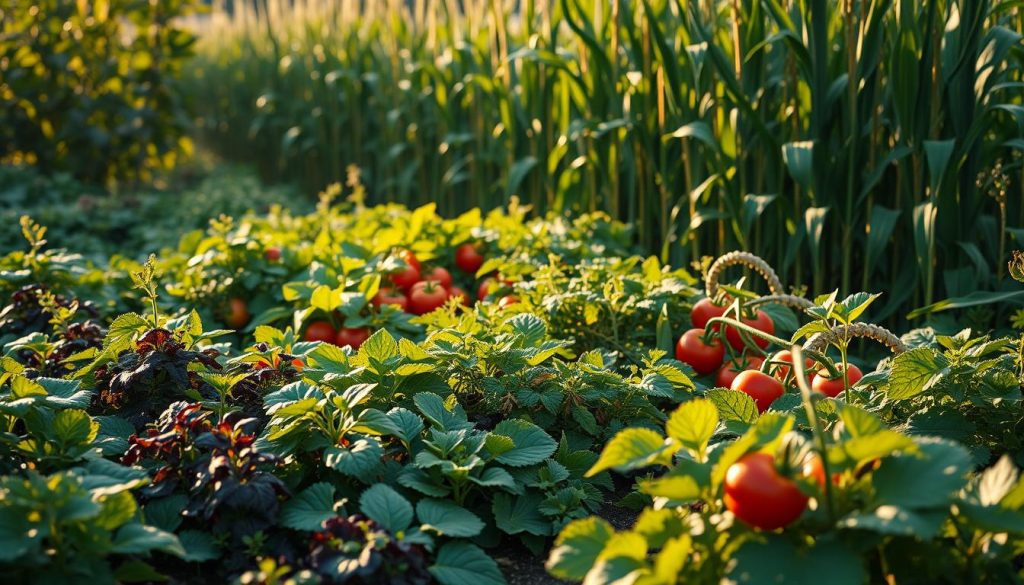
Planting fast-growing crops with slower ones is smart. Radishes can grow between cabbage plants. They’re ready to eat before the cabbage needs the space. Lettuce can grow between tomato plants, giving you two harvests from one spot.
Arugula, baby greens, and green onions are great with slower-growing plants. They give you extra crops from the same space.
Root and Canopy Considerations
Plants with different roots can share the same soil. Deep-rooted plants like tomatoes work well with shallow-rooted ones like lettuce. This way, both plants get what they need without competing.
Plants with different leaves can also share light. Tall plants let sunlight reach lower-growing ones. This is like a forest, where plants of all heights grow together.
Timing Strategies for Continuous Harvests
Intercropping works best with careful timing. Planting new crops as old ones finish keeps your garden busy. For example, after spring peas are done, you can plant beans in the same spot.
Make a planting calendar for your area to plan these changes. In warm places, plant lettuce then okra, then spinach in the fall. In cooler areas, plant radishes and greens before broccoli.
Planting in batches helps avoid too much of one thing. Plant bush beans every two weeks instead of all at once. This way, you get a steady supply of food without waste.
By using intercropping, your garden will be more productive and strong. It will fight off pests and diseases better. Your garden becomes a team working together to give you lots of food from a small space.
Hydroponics and Aquaponics: Soilless Intensity
Hydroponics and aquaponics are top choices for growing plants without soil. They use water to grow plants, saving up to 90% of water compared to soil. These methods are great for small spaces or bad soil, offering a new way to grow food.
Simple Home Hydroponic Systems
Starting with hydroponics is easy, even for beginners. You don’t need to be an engineer or spend a lot on tools. Many simple systems are available for DIY enthusiasts.
Deep Water Culture (DWC) is a great starting point. Plants grow in net pots above water, with their roots in the solution. You can make a DWC system with a plastic container, net pots, clay pellets, and an air pump.
Wick systems use materials to draw water up to plants. Nutrient Film Technique (NFT) systems move water through channels, perfect for greens and herbs. You can make these systems from PVC pipes or rain gutters.
Aquaponics: The Fish and Plant Symbiosis
Aquaponics combines fish and plants in one system. Fish waste feeds plants, and plants clean the water for fish. It’s a natural, sustainable way to grow food.
For home systems, choose hardy fish like tilapia in warm climates. Goldfish and koi are better in cooler areas. Aim for one pound of fish per ten gallons of water and enough space for plants.
Aquaponics saves water and cuts down on waste. It also lets you grow both plants and fish in the same space. Start with a simple setup using an IBC tote or stock tank for fish, connected to grow beds.
Nutrient Management in Water-Based Systems
Knowing about water chemistry is key for growing in water. Plants need nutrients in the right amounts. Commercial nutrients or organic options like worm tea can work well.
Keep the pH level right (5.5-6.5) for nutrient use. Use a digital pH meter to check and adjust. Look out for signs of nutrient issues like yellow leaves or slow growth.
Water-based systems might seem hard at first, but they’re getting easier. They’re great for small spaces or bad soil, making them some of the best ways to grow food.
Permaculture Principles in Intensive Gardens
Permaculture and intensive planting turn gardens into self-sustaining ecosystems. These gardens work with nature, not against it. They become more productive and need less work over time.
Unlike regular gardening, permaculture uses natural processes. It turns challenges into assets and waste into resources.
Creating Garden Guilds and Polycultures
Garden guilds are a key concept in permaculture. They are like natural ecosystems where plants help each other. Unlike single-species gardens, guilds use space efficiently.
A good guild might have a fruit tree at its center. For example, an apple tree guild could include:
- Comfrey as a nutrient accumulator
- Nitrogen-fixing plants like clover
- Aromatic herbs like mint and thyme
- Flowering plants that attract beneficial insects
- Ground covers that suppress weeds
These polycultures increase yields and reduce maintenance. Plants work together, creating a mini-ecosystem that takes care of itself.
Sustainable Water Management
Water efficiency is crucial in permaculture and intensive gardening. Instead of irrigation, permaculture uses natural water flow.
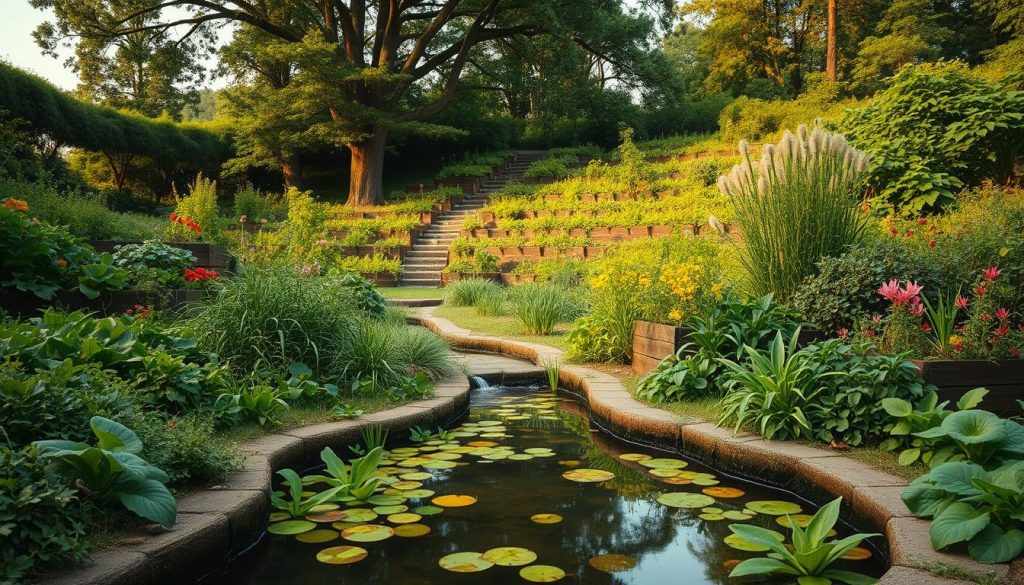
Swales are key in permaculture water management. They slow down water, letting it soak into the soil. This way, gardeners direct rainwater where it’s needed most.
Rain gardens collect runoff and turn it into growing areas. Other techniques include:
- Mulching to reduce evaporation
- Creating microclimates
- Installing rain barrels and cisterns
- Using ollas for efficient irrigation
These methods reduce water use and improve plant health. They are vital for intensive gardens where plants are close together.
Mimicking Natural Ecosystems
The best gardens look like natural ecosystems. They have diverse, multi-layered communities that build soil and resist pests.
Permaculture gardens use “edge effects” for more diversity and productivity. Curved beds and undulating borders increase these edges in small spaces.
Succession planning helps gardeners work with change. Annuals give way to perennials, which support fruit trees. This mimics forest development, creating mature, productive gardens.
By applying permaculture to intensive planting, gardeners create resilient systems. These systems produce abundantly, build soil, conserve water, and support biodiversity. The result is a thriving ecosystem that generates its own resources.
Urban Agriculture: Bringing Intensity to City Spaces
Urban agriculture and intensive planting are turning city spaces into green oases. As cities grow, people are turning empty lots into food gardens. These efforts not only grow fresh food but also connect people with nature in the city.
Balcony and Rooftop Gardens
City gardens now grow up, using balconies and rooftops for food. These small spaces can produce a lot of food with the right systems. For example, a small rooftop bed can grow over 100 pounds of veggies a year.
For rooftop gardens, the weight of the soil is key. A mix of coco coir, perlite, and compost works well. Gardeners also face challenges like strong winds and heat from buildings.
To make the most of small spaces, gardeners use creative methods. They stack plants vertically and use trellises. This way, a small area can grow a variety of plants, like lettuce and tomatoes together.
Community Garden Intensification
Community gardens are where gardeners share ideas and tools. Even small plots can become productive with the right planning. Many gardens now have shared systems like vertical towers or aquaponics.
Sharing knowledge and resources is as important as the gardening itself. Gardeners exchange seeds and tools, and teach each other. This builds strong community bonds and resilient food systems.
| Urban Growing Space | Best Intensive Methods | Key Challenges | Typical Yields |
|---|---|---|---|
| Balcony | Container gardening, vertical systems | Weight limits, wind exposure | 15-25 lbs per season in 20 sq ft |
| Rooftop | Raised beds, square foot gardening | Heat stress, structural concerns | 100+ lbs per season in 32 sq ft |
| Community Plot | Biointensive, intercropping | Limited access time, theft | 200-300 lbs per season in 100 sq ft |
| Indoor Space | Hydroponics, microgreens | Light limitations, humidity control | 5-15 lbs per month in 10 sq ft |
Indoor Growing Systems
Indoor gardening is part of the urban agriculture movement. Even those without outdoor space can grow food indoors. This includes everything from herbs to complex systems with special lighting.
Hydroponic systems are great for indoor gardening. They use 90% less water than soil gardening and don’t worry about weather. LED grow lights are also affordable and efficient, helping plants grow well indoors.
Choosing the right plants is key for indoor gardening. Fast-growing plants like microgreens and herbs do well in low light. Gardeners often move seedlings outdoors when the weather is better, extending their growing season.
Overcoming Challenges of High-Density Planting
Mastering intensive planting methods means tackling several key challenges. These challenges come from growing more in less space. But, with the right planning and observation, these issues can be managed well.
Disease and Pest Management
High-density planting can lead to higher humidity, which may increase disease risk. Plants close together also make it easier for pests to spread. But, there are ways to fight these problems without using harmful chemicals.
Organic Prevention Strategies
The best way to protect your garden is to prevent problems:
- Choose disease-resistant varieties suited to your climate
- Practice proper spacing within your intensive system
- Implement regular crop rotation, even in small spaces
- Apply organic mulches to prevent soil-borne disease splash
- Prune for airflow in dense plantings
Beneficial Insects and Biodiversity
Helpful creatures can turn your garden into a self-regulating system. Plant herbs like dill and fennel to attract predators. Leave areas for native plants to act as insect “hotels.” Diverse plantings resist pests better than single types, making biodiversity key to garden health.
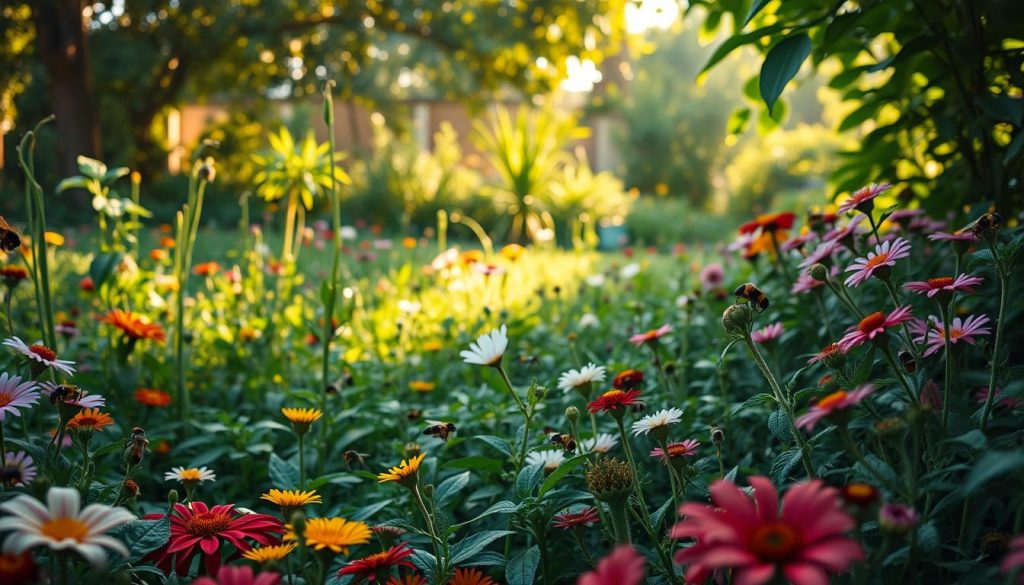
Irrigation Solutions
Dense plantings need consistent moisture but can face drought or waterlogging. Efficient irrigation is crucial when plants compete for water.
Drip irrigation systems deliver water precisely, reducing waste. Self-watering containers and ollas provide steady moisture to roots. Mulching is also vital in intensive systems, keeping moisture in and soil temperature stable.
For small spaces, consider automated micro-irrigation systems with timers. They ensure plants get water even when you’re busy.
Preventing Nutrient Depletion
Intensive planting methods increase soil nutrient demand. Without proper management, soil can quickly lose fertility. This leads to lower yields.
Build soil fertility by adding quality compost regularly. Use cover crops like clover to add organic matter and fix nitrogen. Targeted amendments based on soil tests are better than general fertilizers.
Foliar feeding with compost tea gives quick nutrient boosts. Refresh container growing mediums annually and use organic fertilizers for specific crops.
Even in small spaces, rotate crops to prevent nutrient depletion and disease buildup. Divide your garden into sections that rotate through plant families.
Embracing the Future of Garden Abundance
As space and resources become scarcer, intensive planting methods offer hope. They provide more food from less land, use less water, and fight weeds. Plus, they work with nature, not against it.
Start small to see big results. Turn one garden bed into a square foot garden or add a vertical garden. These steps show the power of intensive gardening without a big change.
Climate change makes these methods crucial. Gardens that use space wisely and need less will survive best. They also need less care once set up.
New tools and techniques are coming. Smart irrigation and compact plants are just the start. Urban and suburban gardeners worldwide are growing their own food, making a difference.
No matter the size of your space, intensive gardening can make it productive. It’s not just about growing more. It’s about creating a sustainable food system for the future.

